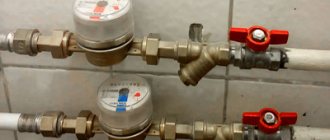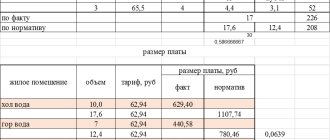Water supply tariffs in Russia
In the Russian Federation, the cost of cold water and a separate tariff for hot water supply have been established. Its size is regulated by the authorities of the subject of the federation and local self-government, so prices for utility services are not the same in the regions.
The tariff is set taking into account the costs that local water utilities and heating networks incur in connection with the supply of the resource, as well as the surcharges added to them within the limits of the indices established for the region.
Typically, the water tariff is calculated based on the costs of:
- electricity and reagents for water purification;
- employee salaries;
- transportation of the resource to the final consumer;
- maintenance of water utility property, utility networks, and so on.
As for hot water supply (DHW), its tariff consists of the price for the supply of cold water, the cost of heating it to the required temperature and the tariff growth index.
In 2021, as in previous years, tariff increases are planned for the second half of the year, in accordance with the order of the Government of the Russian Federation dated October 30, 2020 No. 2827-r.
DHW temperature standards
As mentioned above, the amount of payment for a hot water supply utility service is determined, among other things, based on the cost of heating it - this is the largest expense item.
Most consumers would like to understand what they are paying for. One of the main criteria for the quality of the service provided is the temperature of the supplied hot water. According to SanPiN 2.1.4.2496-09, approved. , the temperature of hot water in the tap should not be lower than 60 and not higher than 75˚C.
Sanitary standards mention the permissible limit of deviations from the norm. So, from 12 at night to 5 in the morning, fluctuations can be ± 5˚С, at any other time – ± 3˚С.
Consequently, the temperature of the water in the hot tap cannot fall below 55–57˚C. Violation of this norm gives residents the right to seek a tariff reduction of 0.1% for each hour during the entire period of deviation.
Two-component tariff for hot water supply: what is it?
In 2021, payments for hot water consumed by the population must be made according to a two-component tariff. Previously it was assumed that this would happen before 2018. Let's figure out what it is.
The concept of “tariff for hot water” as a single product is not used anywhere in the world - most often it is heated directly at the heating supply facility. But even where the practice of centralized supply of hot water still exists, the product is primarily the coolant that heats this water.
Following international experience, the Russian authorities introduced the so-called two-component tariff for hot water supply in 2013. The calculation of the payment for hot water according to the two-component tariff in the housing and communal services receipt in closed water supply systems is carried out based on the following components:
- the actual volume of cold water used, paid at the standard tariff for cold water;
- the actual amount of heat used to heat cold water. It is paid at a separate rate.
Simply put, the cost of hot water at the tap is determined by the prices of cold water and thermal energy to heat it.
The volume of resource consumed is determined by the hot water meter, and if it is missing, by the generally accepted consumption standard. Payment for water heating in utility bills is calculated according to the standard heat consumption used for heating.
In open water supply systems the following components are used:
- coolant;
- thermal energy for water supply purposes.
Currently, regional executive authorities are authorized to independently decide which principle for calculating the cost of hot water supply to use to determine the tariff in a closed system: one-component or two-component. By 2021 they must finally switch to a two-part tariff, and until then a special regulatory framework needs to be developed.
What is DHW in the receipt?
The abbreviation “DHW” is nothing more than hot water supply. They are provided with apartments in houses. In this case, the hot water supplied to homes must correspond to a certain temperature regime. DHW does not mean only hot water. This is thermal energy used to heat water to the required temperature.
DHW can be supplied to apartments through central and autonomous systems. The first option is the most common and is used in apartment buildings. Water is heated at a thermal station, after which the resource is supplied to homes. The autonomous system has found application in private homes. A boiler or a special boiler installed in the premises heats the water. The resource is subsequently distributed only within one private home.
Hot water supply is paid only by citizens using the central heating system. Users of an autonomous system do not pay for the resource itself, but only for heating it using electricity or gas.
Note! Receipts also contain the column “DHW at one-way service station”. The last abbreviation means general house needs (pressure testing of pipes, preparation for seasonal heating, delivery of coolant to common areas). Domestic hot water supply on one heating system implies the consumption of energy to heat water, which will be used for the needs of all inhabitants of the house, and not just individual apartments in it.
Normative base
The possibility of applying a two-component tariff for hot water supply is established by the following laws:
- clause 9 art. 32 – in closed systems;
- clause 5 art. 9 – in open water supply systems.
But these laws only determine the possibility and components of such a tariff, and specific provisions are contained in the by-laws.
In particular, the obligation to establish water and heat consumption standards, as well as switch to a two-component tariff from 2021, rests with the regional authorities in clause 2. He also makes changes to the Rules for determining standards for the consumption of utility services, approved. , and Rules for the provision of public services, approved. .
According to the listed documents, the authorized body is obliged to establish a heat standard for heating water, taking into account:
- water supply systems;
- design features of apartment buildings;
- availability of water folding devices;
- sanitary equipment and so on.
Water heating equipment
A water heater is installed in an apartment building. Failure of the device does not affect the tariff change. But the repair of a broken water heater is paid for by the residents of the house. The device is part of the common property. If it breaks down in the housing and communal services receipt, in the line “Repair of property” there will be a certain amount spent on fixing the problem.
Important! Residents of apartments equipped with an autonomous system do not have to pay for water heating. They do not use the central system and pay only for the amount of electricity or gas spent on heating the resource with a home boiler or boiler.
What is “thermal energy”
For DHW purposes, it is necessary to simultaneously take into account two components for which the subscriber pays: cold water (or coolant, if we are talking about open systems) and thermal energy.
With water, everything is clear - it is calculated in m3 depending on the meter readings or consumption standards. But not everyone is familiar with the concept of “thermal energy” and what function it performs.
This component is the main component of heating cold water to established standards. To determine the amount of thermal energy expended, you need to multiply the amount of water used by the heat standard required to heat 1 m3. This standard is adopted by local authorities.
If the standard is not established, housing offices and other management organizations calculate it independently using the formula approved. Government Decree No. 306.
Consequently, a one-component tariff for hot water is when the subscriber pays only for the cubic meters of water used, a two-component tariff is when the cost of heating it is also included in the tariff.
The average consumption of thermal energy for hot water supply to the consumer is determined using formulas 20 and 21
(20)
(21)
where: Qgv, Qgvl - average heat consumption for direct hot water supply to the consumer without taking into account heat losses, respectively, in winter and summer, W;
a is the rate of water consumption for hot water supply, l/day per person, approved by local authorities or management. In the absence of approved ports, it is accepted according to the application in accordance with SNiP 2.04.01-85;
m - the number of units of measurement per day (number of residents, students in educational institutions, beds in hospitals)
tхз, tхл - average temperature of cold (tap) water in winter and summer, respectively, °C. Taken during the heating period tхз=5оС, in the summer period tхл=15оС;
c is the specific heat capacity of water, in calculations we take it equal to 4.187 kJ/(kg °C)
0.28 is the conversion factor for the dimensions of physical quantities.
Note: we find the number of residents of residential buildings based on the calculation of n+1 people per n-room apartment, for the remaining buildings we find it according to Appendix B based on the volume of the building given to us and the results obtained experimentally for buildings of a different volume, but of the same type.
m - found by the formula:
m=V/v (22)
where: m is the number of units of measurement per day;
V is the volume of the building according to external dimensions, m3;
c- obtained experimentally, obtained by application
Table 5.1 - average heat consumption for hot water supply in summer for various types of buildings
| Building type | a, l/day person | m, units | Qsrgvz,W | Qsrgvl,W |
| Residential building 9 floors | 120 | 297 | 87047,73 | 69638,18 |
| Residential building 5 floors | 120 | 165 | 48359,85 | 38687,88 |
| Residential building 12 floors | 120 | 132 | 38687,88 | 30950,3 |
| Administrative buildings | 7 | 132 | 2256,79 | 1805,43 |
| Cinemas | 5 | 600 | 7327,25 | 5861,8 |
| Theaters | 5 | 750 | 9159,06 | 7327,25 |
| Kindergartens | 30 | 139 | 10184,87 | 8147,90 |
| Schools | 8 | 100 | 1953,93 | 1813,28 |
| Clinics | 6 | 972 | 14244,17 | 11395,33 |
| Hospitals | 180 | 224 | 98478,24 | 78782,59 |
| Hotels | 200 | 225 | 109908,75 | 87927,00 |
The required amount of heat for hot water supply needs for a certain period is determined by the formula:
(23)
where: nз, nл - the number of hours of operation of the hot water supply system per day, respectively, in winter and summer, hours.
zз, zл - duration of operation of the hot water supply system
respectively in winter and summer, days.
The calculated values of the required amount of heat for the needs of hot water supply for a certain period are shown in Table 5.2.
Table 5.2 - Calculated values of the required amount of heat for hot water supply needs for various types of buildings
| Building type | Qsrgvz,W | nz, h | zz, days | Qsrgvl,W | nl,h | zl, days | Qgv,gJ |
| Residential building 9 floors | 87047,73 | 24 | 250 | 69638,18 | 24 | 85 | 2391,65 |
| Residential building 5 floors | 48359,85 | 24 | 250 | 38687,88 | 24 | 85 | 1328,70 |
| Residential building 12 floors | 38687,88 | 24 | 250 | 30950,3 | 24 | 85 | 1062,96 |
| Administrative buildings | 2256,79 | 12 | 250 | 1805,43 | 12 | 85 | 31,00 |
| Cinemas | 7327,25 | 16 | 250 | 5861,8 | 16 | 85 | 134,21 |
| Theaters | 9159,06 | 5 | 250 | 7327,25 | 5 | 25 | 44,51 |
| Kindergartens | 10184,87 | 16 | 250 | 8147,90 | 16 | 85 | 186,55 |
| Schools | 1953,93 | 12 | 250 | 1813,28 | 12 | 25 | 23,06 |
| Clinics | 14244,17 | 12 | 250 | 11395,33 | 12 | 85 | 195,68 |
| Hospitals | 98478,24 | 24 | 250 | 78782,59 | 24 | 85 | 2705,71 |
| Hotels | 109908,75 | 24 | 250 | 87927,00 | 24 | 85 | 3019,76 |
Note: the number of days of hot water supply in summer for residential buildings, administrative buildings, cinemas, kindergartens, clinics, hospitals and hotels is determined by the formula:
Zl=365-Zht-30
where: Zht is the duration of the heating season in days;
30 - the number of days allocated for repairing the heating main.
For schools and theaters, the number of days of hot water supply in summer is determined by the formula:
Zl=365-Zht-30-60
where: Zht is the duration of the heating season in days;
30 - the number of days allocated for repairing the heating main.
60 - summer holidays (tours).
Determining the load on the DHW source.
Table 5.3 - Calculated values of thermal load on the source of hot water supply
| Building type | Qgv,gJ | Number of buildings, pcs | Qgw total, gJ |
| Residential building 9 floors | 1700 | 17 | 40658,11 |
| Residential building 5 floors | 944,45 | 14 | 18601,75 |
| Residential building 12 floors | 75,56 | 7 | 7440,7 |
| Administrative buildings | 30,36 | 3 | 93,00861 |
| Cinemas | 262,35 | 2 | 268,4235 |
| Theaters | 86,65 | 1 | 44,51303 |
| Kindergartens | 182,18 | 4 | 746,217 |
| Schools | 60,86 | 5 | 115,3039 |
| Clinics | 191,28 | 2 | 391,3614 |
| Hospitals | 2646,99 | 1 | 2705,709 |
| Hotels | 2957,46 | 1 | 3019,765 |
(25)
Will there be an increase in the cost of hot water in 2021?
The issue of tariff growth is perhaps the most socially significant for the country's population. Therefore, it is worth immediately reassuring readers: a significant increase in utility tariffs is not expected in 2021. However, the cost of hot water supply services will still increase.
Both the hot water tariff per cubic meter and the two-part tariff, if adopted in the region, according to the order in accordance with the order of the Government of the Russian Federation dated October 30, 2020 No. 2827-r, will be increased from July 1, 2020.
Different increases are allowed for each region. The average indices are determined by the specified order. The cost of utilities cannot rise above the established limits.
But the index specified in the order is a maximum, and not a mandatory, percentage increase. Thus, regional authorities decide what the tariff for heating hot water is from July 1, 2018.
More information in the material “Increase in housing and communal services tariffs in 2021.”
The procedure for calculating the cost of hot water supply according to a two-component tariff
The legislative framework regarding accounting and payment for domestic hot water services at a two-rate tariff is quite complex. To understand how to calculate a hot water tariff from two components, you need to be a professional. Taking this into account, many regions of the Russian Federation have published special practical explanations and instructions designed to convey to citizens the procedure for applying tariffs for hot water. Having studied the published methodological recommendations, we tried to generalize regional practice.
How the cost of hot water is calculated according to a two-component tariff in apartments depends on the presence or absence of an individual water meter in the residential premises. For calculations, formula No. 23 is used, approved. Appendix 2 to the Rules, approved. Government Decree No. 354.
This formula assumes taking into account the readings of water meters and standards for heat consumption required for heating. So, if there is a hot water meter in the apartment, the calculation of hot water supply in an apartment building in 2021 is carried out as follows:
Cost of 1 m3 cold. water x consumption volume + (consumption volume x heat consumption standard) x cost of 1 Gcal of heat = cost of DHW services
For example: the cost of 1 m3 of cold. water is 30.09 rubles, consumption volume is 5 m3, heat consumption standard is 0.06, and the cost of 1 Gcal of heat is 1775.45 rubles. Then the calculation looks like this:
30.09*5+(5*0.06)*1775.45 = 683.08 rub.
If there is no individual meter, instead of the actually consumed resource, the local standard is taken into account in the formula. Let it be 3.89 m3/person. Therefore, if 3 people live in an apartment, the calculation procedure is as follows:
(30.09 x 3.89+(3.89 x 0.06) x 1775.45) x 3 = 1360.22 rubles
We will also consider a simple calculation option for those who are interested in how to calculate the hot water tariff per 1 m3, converting it into a single-component one. So, the actual cost of 1 m3 of hot water in our case is calculated as follows:
30.09+1775.45 x 0.06=136.17 rubles/m3
Are there any differences in tariffs with and without a meter?
As can be seen from the above, the cost of hot water supply does not depend on whether the subscriber has an individual metering device: the tariff for hot water according to the meter is always the same. In the calculations, only consumption volumes change:
- if there is a counter, the actual volume is used;
- without a metering device - standard.
This is also reflected in the final cost of consumed resources. The more residents there are registered in the apartment, the higher the utility costs will be.
In addition, the state is trying in every possible way to encourage the population to install metering devices. One of the incentives is the introduction in 2017 of an increasing coefficient for subscribers who have the technical ability to install meters, but do not do so.
For apartments without metering devices, an increasing factor of x = 1.5 is applied (increase by 50%).
So, using the data from the above calculation, you can see that for residents who have not installed metering devices, 1 m3 of hot water will cost not 136.17 rubles, but already 151.662 rubles. (30.09 x 1.5 + 1775.45 x 0.06).
To learn how to avoid an increase, read the article “How to install a water meter in an apartment.”
How do you pay me for heat and hot water? We understand the charges for residents of Novosibirsk
This year, economic instability due to the pandemic has affected many people in the country. Novosibirsk was no exception. People began to take more care of their finances and calculate their monthly budgets more carefully. Especially when it comes to such an important expense item as paying for utilities.
Novosibirsk residents often have a question: how do they pay for heating and hot water?
Heating
In Novosibirsk and the Novosibirsk region, the heating fee is calculated at 1/12, that is, evenly throughout the calendar year, including the summer months. This is done so that payments from the population do not increase sharply and it is possible to pay for the service in equal installments throughout the year.
This procedure was approved by the Government of the Novosibirsk Region in 2016 (Resolution of the Government of the Novosibirsk Region No. 211-p dated July 14, 2021), in accordance with Resolution of the Government of the Russian Federation dated May 6, 2011 No. 354. According to the latter, each subject of the Federation chooses the procedure for charging fees for thermal energy.
In apartment buildings equipped with common building metering devices (CDMU), the monthly payment is based on the actual heat consumption in the previous year according to the meter readings.
A separate topic is annual adjustment. It is done next year based on the results of the previous year. That is, in 2021 they will make an adjustment based on the results of 2021 - recalculate the difference between the heat actually consumed (according to the TDPU) and the heat accrued in 2021. The difference is the annual adjustment. We will talk about it in more detail in the next article.
Now let's calculate your monthly payment according to the 1/12 scheme. To do this you need:
- average monthly consumption according to the accounting period for the accounting year (in your management company or in the Siberian Generating Company, if you have a direct agreement with it),
- total area of the house (total area of residential and non-residential premises),
- apartment area.
You also need to know the tariff (by the way, in the Novosibirsk region it is one of the lowest in Russia and is now 1,467.82 rubles per Gcal).
And calculate according to the diagram in the infographic:
How do you pay for heat?
Following the scheme, after carrying out a simple calculation, each resident will be able to check their management company and make sure that everything is calculated correctly.
It is important to know! If the house is equipped with individual heat energy metering devices (IMU), the heating fee will be calculated for each apartment based on the average monthly heat energy consumption for the previous year, which was recorded by the meter in this apartment, regardless of its area. There will also be an annual adjustment next year.
In the absence of readings from a common house meter for the previous year, payment for heat is calculated based on the consumption standard.
Hot water
We often receive messages asking why the amount on the receipt for hot water is several times higher than before. Considering that the tariff is the same as last month.
Perhaps, now it is unlikely that anyone can be surprised by individual metering devices installed in apartments. This device helps to calculate how much hot water the tenant has used. It is only necessary to submit the testimony on time. Otherwise, they will calculate according to the standard, in which case the amount will be significantly higher.
In order for the tenant to be charged only for the water actually used, it is necessary to submit meter readings on time - from the 23rd to the 26th
- If the consumer’s home is equipped with an IPU
, then the calculation will be made according to the formula:
Consumption according to IPU * price per cubic meter (cube) = this will be the amount of charge for hot water supply.
The current tariff for hot water for residents of Novosibirsk is 114.54 rubles. per cubic meter, Kuibyshev - 120.32 rubles. per cubic meter, and in other municipalities of the Novosibirsk region it is 109.54 rubles. per cubic meter
To pay for hot water consumed, the owner only needs to submit testimony to his management organization every month from the 23rd to the 26th.
If the consumer does not have time to submit the readings, over the next three months he will be calculated according to the average monthly hot water consumption, and then according to the standard.
- According to the standard, they are also charged to those who do not have an IPU
. In this case, the calculation formula will look like this:
Consumption standard * number of residents * price per cubic meter * increasing factor (1.5) = amount of charge for hot water supply.
By the way, an increasing coefficient is used if the apartment does not have a hot water meter, but it is technically possible to install it.
The standard for hot water consumption in Novosibirsk is 3.687 cubic meters. meter per person. However, it may differ in different houses, depending on the degree of improvement of the living space.
We conclude that when paying for heating, residents only pay for what they consume.
The same as for hot water in the presence of IPU. Therefore, it is important to transmit meter readings in a timely manner in order to charge for actually consumed cubic meters of hot water.
Controversial aspects of the application of a two-component tariff
Despite a fairly transparent calculation scheme, the use of a two-component tariff seems quite controversial, as evidenced by contradictory judicial practice. Below we look at some of the most high-profile cases.
Public meter readings
One of the most controversial issues is the use of a common house heat meter when calculating for domestic hot water. It would seem that its presence makes it possible to objectively measure the amount of heat expended by the resource supplier to heat water, and this practice is the only correct one. In reality, not everything is so simple.
According to the Rules for the Provision of Utility Services, when calculating the cost of hot water supply, only the established standards for heat used to heat water should be used.
Even if the heat meter is used under a contract, its indicators still cannot be taken into account when making payments to consumers and domestic hot water suppliers.
This position was supported by the Ministry of Construction of the Russian Federation and the Supreme Court, although it potentially leads to an unreasonable increase in the cost of the resource.
Imperfect calculations
As is known, in the regions, the receipt for heating and hot water may contain different standards for the heat spent on heating a cubic meter of water. The difference between some regions exceeds 15%. For example, in the Omsk region the standard is 0.0503 Gcal/1m3, in St. Petersburg - 0.06 Gcal/1m3, and in the Rostov region - from 0.054 to 0.066 Gcal/1m3, depending on the design features of the house.
Probably the reason for this difference is the uncertainty in the calculations regarding the temperature of the water that needs to be heated and the temperature of the already hot water. Temperature changes at different times of the year are not taken into account in the calculations, which leads to inflated tariffs for hot water supply.
Design features of houses
The use of a two-component tariff has created a problem for management organizations that service houses equipped with heated towel rails, heated floors, and so on.
The peculiarity of the hot water supply system of such houses is that the water circulating in the circuit should not cool down. This requires additional heat (about 30% of the total amount of heat used to heat the water).
Payments between management companies and residents are carried out based on apartment meters, which do not take into account these losses. As a result, the management company receives 25-35% less money from residents than it must pay to the hot water supply supplier.
How to make your own calculation
The correctness of the amounts calculated by settlement centers can be verified. To calculate the cost of hot water supply, you will first need to find out what the price of thermal energy is at a given time. The final amount of the calculation is influenced by the presence of a water meter in the home. If there is a flow meter in the apartment, then the readings from it are taken into account. If there is no water meter in the home, then the standard is taken into account in the calculations. This is an average indicator of the consumption of thermal energy used to heat water. The standard is approved by the energy supply company.
If there is a general energy flow meter in the house and a water meter in a separate apartment, the amount for hot water supply is formed on the basis of the indicators of the general house flow meter and the subsequent proportionate distribution of the resource among apartments. If the house does not have a general house flow meter, then the calculation is made based on data from individual water meters and the established norm of energy consumption per 1 m3.
The amount that a resident needs to pay for hot water supply can be calculated using a single formula:
- P = Vhot.in * Tcold.in + (Vheat.energy * Vhot.in / ∑Vhor.in * Theat.energy)
In this formula, the designations are deciphered as follows:
- Vhot.v is the volume of hot water consumed in the home over a monthly period;
- Tcol.w – cost of cold water at a fixed tariff;
- Vtherm.energy – the amount of heat energy used during the month to heat cold water;
- ∑Vgor.v – the total amount of hot water consumed by all apartments in the building during the month;
- Theat energy – the tariff set for heat energy.
Using this formula, DHW is calculated for those apartments where individual flow meters are installed. If the housing does not have these, then the calculation is made on the basis of the standard established in the region. Its value must be divided by the number of registered occupants of the apartment. However, the final result is inaccurate. Housing organizations involved in settlements additionally include in receipts expenses for repairs and maintenance of metering devices in houses.
When making calculations, it is important to find out how hot water supplies the apartments. It can be supplied either through common house equipment or through a centralized system. If DHW is supplied to the apartment using common building equipment, and it has hot and cold water supply meters, then the calculation is done in the following way:
- DHW flow meter readings * tariff for cold water supply * cost of heat energy.
If an apartment dweller’s hot water meter shows 2 m3, the tariff for cold water is 14 rubles, and the cost of heat energy is 2000 rubles, then the calculation will be as follows: 0.06 gigacalories * 2000 = 240 rubles. + (14 * 3) = 282 rub. This is the price of 2 m3 of hot water. The number 0.06 indicates the approximate amount of energy used to heat 1 m3 of water. If your home does not have water meters, then you must first multiply the standard by 0.06, and then multiply the resulting product again by the heat tariff.











